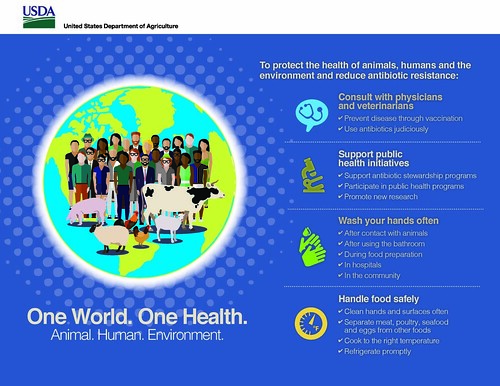
This week is World Antibiotic Awareness Week and USDA remains focused on prolonging the usefulness of a very precious resource—antibiotics. These medicines successfully treat and prevent infectious diseases and must be used responsibly to remain effective to all who need them. USDA also recognizes that antimicrobial resistance, or the ability of bacteria and other microbes to survive the effects of an antibiotic and then proliferate, is a serious threat to both animal health and human health.
Earlier this year, the World Health Assembly developed a global action plan to combat antimicrobial resistance (AMR). The five objectives of the plan are: Increasing awareness, strengthening research and surveillance, reducing infections, optimizing antimicrobial use, and ensuring sustainable investments to contain AMR.
At USDA, we use a One Health approach that embraces the idea that a problem such as AMR arising at the intersection of the health of humans, animals, and the environment can be solved only through a coordinated multidisciplinary approach.
Within USDA, there are eight agencies engaged in addressing some aspect of AMR: the Agricultural Research Service, the Agricultural Marketing Service, the Animal and Plant Health Inspection Service, the Economic Research Service, the Food Safety and Inspection Service, the Foreign Agricultural Service, the National Agricultural Statistics Service, and the National Institutes for Food and Agriculture. Our One Health Joint Working Group within USDA coordinates the work of these agencies for a comprehensive approach to address multiple facets of the issue.
Last year, USDA developed an AMR Action Plan based on broad stakeholder and federal partner feedback. The USDA AMR Action Plan (PDF, 322 KB) outlines USDA’s current activities across USDA agencies and proposes a comprehensive, integrated approach for future activities that includes monitoring and surveillance; research and development; and education and outreach. Data collection through monitoring and surveillance provides the fuel for targeting research into epidemiology, ecology, and preventive health approaches allowing for development of critical mitigation strategies. Education and outreach are necessary to spread the word and enhance implementation of findings.
USDA’s AMR Action Plan provides the details of USDA’s responsibilities outlined in the Combating Antibiotic Resistant Bacteria (CARB) National Action Plan, developed with our federal partners. In both of these plans, we take advantage of the strengths of our existing activities and collective experience in animal agriculture and describe additional work necessary to fill knowledge gaps.
Our understanding of the factors that contribute to development of infectious disease, which includes those that are resistant to antibiotics in various settings, is incomplete. Agricultural systems are diverse and complex even within a specific commodity group. To identify and apply effective mitigation strategies, it is critical for many disciplines to work together to improve our understanding of where pathogens originate, how they interact in the environment, and how we can effectively diminish their occurrence. A “One-Health” approach is needed to prevent, not just react to, complex public and animal health issues. We also recognize that for prevention to be effective, we need to invest resources in a variety of strategies. Risk management requires collaboration among human, animal, and environmental sectors.
The theme of the World Antibiotic Awareness Week campaign this year is, Antibiotics: Handle with Care. You can find what some of our stakeholders are doing to preserve this valuable resource through a Fact Sheet distributed during the White House Forum on Antibiotic Stewardship held June 2, 2015.

